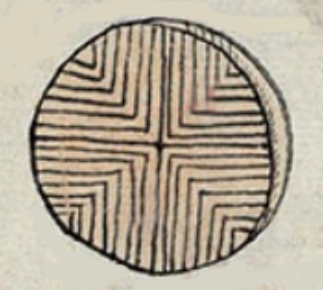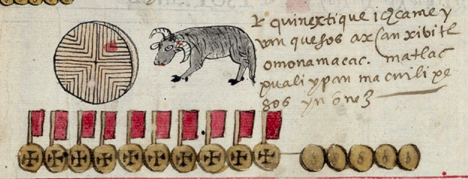queso (CST47)
This is a painting of the simplex glyph for the term queso (cheese, a loanword that entered Nahuatl from Spanish). It shows a bird’s eye view of a full round of cheese. It has an intricate pattern pressed into the exterior. This forms quadrants, and each quadrant has a series of nesting right angles. The result is something like a quincunx shape.
Stephanie Wood
For more on the Codex Sierra, see Kevin Terraciano’s study (2021).
Stephanie Wood
1550–1564
Jeff Haskett-Wood
economía, mercancías, ventas, comercio, comida, rondas de queso

queso (a loanword that entered Nahuatl from Spanish), cheese, or a round of cheese, https://nahuatl.wired-humanities.org/content/queso
queso
Stephanie Wood
Códice Sierra-Texupan, plate 47, page dated 1561. Origin: Santa Catalina Texupan, Mixteca Alta, State of Oaxaca. Kevin Terraciano has published an outstanding study of this manuscript (Codex Sierra, 2021), and in his book he refers to alphabetic and “pictorial” writing, not hieroglyphic writing. We are still counting some of the imagery from this source as hieroglyphic writing, but we are also including examples of “iconography” where the images verge on European style illustrations or scenes showing activities. We have this iconography category so that such images can be fruitfully compared with hieroglyphs. Hieroglyphic writing was evolving as a result of the influence of European illustrations, and even alphabetic writing impacted it.
https://bidilaf.buap.mx/objeto.xql?id=48281&busqueda=Texupan&action=search
The Biblioteca Digital Lafragua of the Biblioteca Histórica José María Lafragua in Puebla, Mexico, publishes this Códice Sierra-Texupan, 1550–1564 (62pp., 30.7 x 21.8 cm.), referring to it as being in the “Public Domain.” This image is published here under a Creative Commons license, asking that you cite the Biblioteca Digital Lafragua and this Visual Lexicon of Aztec Hieroglyphs.


